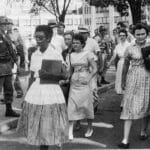Beyond the Scream: The Life and Legacy of Hazel Bryan
Meet Hazel Bryan, a name forever intertwined with one of the most tumultuous periods in American history: the fight for civil rights. You might not immediately recognize her name, but the image of her, face contorted in anger, sneering at a young Elizabeth Eckford during the integration of Little Rock Central High School in 1957, is seared into the collective memory of a nation grappling with its deeply ingrained racism. Captured by photographer Will Counts, the photograph became an enduring symbol of the hate and resistance that the civil rights movement sought to dismantle. However, Hazel Bryan’s story, much like the fight for racial equality itself, is far from simple. It’s a complex narrative of regret, a lifelong quest for redemption, and the elusive nature of forgiveness.
Growing up in the racially charged environment of Little Rock, Arkansas, Bryan, like many others, absorbed the prejudices of her time. It was in this context that she found herself at Central High School on that fateful day, swept up in a maelstrom of social change and entrenched opposition. The now-iconic photograph of her, seemingly jeering as Elizabeth Eckford, one of the nine Black students bravely attempting to integrate the school, walked past a hostile crowd, immortalized a moment of raw, unadulterated prejudice. This image, frozen in time, would become a searing indictment of the era and a personal albatross for Bryan.
A Life Marked by Regret and the Search for Redemption
In the aftermath of Little Rock, Bryan attempted to distance herself from the event that had come to define her. She married, had a family, and seemingly moved on with her life. But the past, like a stubborn stain, refused to fade. The weight of her actions, the knowledge that she had played a part in inflicting such pain and humiliation, gnawed at her conscience. The anger and fear that had fueled her actions as a teenager gave way to a profound sense of remorse and a desperate yearning to make amends.
Driven by this guilt, Bryan eventually reached out to Eckford, seeking atonement for her past transgressions. This act of contrition culminated in a public apology in 1997, a gesture that Eckford initially accepted. The image of the two women, once separated by a chasm of hatred, now embracing, seemed to offer a glimmer of hope, a testament to the transformative power of forgiveness.
However, the reconciliation proved to be more complex than initially perceived. Eckford would later express her reservations, questioning the sincerity of Bryan’s remorse. She wondered if it stemmed from genuine understanding and a commitment to combating racism, or from a desire to alleviate personal guilt. This element of doubt cast a shadow over the reconciliation, highlighting the enduring wounds of prejudice and the intricate dance between forgiveness and skepticism that often characterizes such encounters.
Beyond the Photo: Examining Hazel Bryan’s Transformation
Despite her attempts to atone, Bryan never truly escaped the shadow of her past. She continued to grapple with the consequences of her actions, acutely aware that the harm she inflicted could never be fully erased. The photograph, a constant reminder of her transgression, followed her throughout her life, a symbol of the enduring impact of racism and the complexities of redemption.
While forever linked to that single image, Bryan’s life story extends far beyond that infamous day. Driven by remorse, she dedicated much of her later life to making amends, actively participating in racial reconciliation efforts, speaking out against racism, and working to bridge racial divides. Was it a complete transformation? Was it enough? These are questions without easy answers, questions that continue to spark debate and reflection.
Bryan’s death in 2011 marked the closing chapter of a life forever entangled with one of the most tumultuous periods in American history. Her story, far from a simple tale of good versus evil, offers a nuanced perspective on the enduring legacy of racism and the arduous path towards reconciliation. It compels us to confront uncomfortable truths about our own capacity for prejudice and the challenges of achieving genuine forgiveness and understanding.
Analyzing Hazel Bryan and Elizabeth Eckford’s Relationship:
The picture of Hazel Bryan, mouth agape in a sneer, taunting Elizabeth Eckford as she tried to walk into Little Rock Central High School back in 1957 – it’s an image burned into America’s memory of racial division. Decades later, these two women, once on opposite sides of history, appeared together, saying they’d made peace. It made everyone wonder: could these two really be friends after all that?
At first, it felt like a beacon of hope, a testament to the power of forgiveness. Hazel Bryan really seemed to regret what she’d done, publicly apologizing and expressing deep shame. Elizabeth Eckford accepted her apology – she recognized that Bryan was, at the very least, trying to make things right. They were seen together, giving talks, doing interviews, looking like the most unlikely of friends. They attended flower shows, bought fabrics, took mineral baths and massages together, and appeared in documentaries and before school groups.
But beneath the surface, things were much more complicated. While Bryan sought forgiveness and a sense of closure, Eckford remained cautious. The scars of that day, the trauma of that experience, ran deep. The relationship, always fragile, ultimately dissolved, a stark reminder of how deeply racism runs and how hard true reconciliation can be.
[Read an exciting story about an immigrant tailor, Henry Tandey, who played a vital role in the American Revolution. Dive into the life of Hercules Mulligan, a tailor and spy who helped George Washington in the war. And don’t miss the captivating tale of Hazel Massery, a female spy who risked her life for the cause of freedom.]
Why Did Hazel Bryan Retreat from Public View?
You see, after that day at Little Rock, Hazel Bryan found herself living under a dark cloud of her own making. The photograph, that single image of her yelling at Elizabeth Eckford, became a symbol of everything wrong in that era. It was everywhere, a constant reminder of the ugliness of racism.
Bryan’s attempts to make amends with Eckford, while genuine, ultimately faltered. Imagine carrying the weight of that photo, the judgment in people’s eyes, wherever you go. The truth is, no matter what Hazel did, she couldn’t escape that moment. The criticism, the whispers, the fear of public backlash – it all became too much.
Around 2001, Hazel Bryan made a choice. She decided to withdraw from the public eye, to seek refuge from the constant scrutiny. It’s a stark reminder of how a single action can reverberate throughout a lifetime, and how difficult it can be to outrun the shadow of the past.
What Defined Hazel Bryan’s Life?
Hazel Bryan’s name became inextricably linked to the Little Rock Nine Crisis, a pivotal moment in the fight for civil rights in 1957. At just 15 years old, Bryan was captured in a photograph that quickly became an emblem of that era – a snapshot of her seemingly shouting at Elizabeth Eckford. Eckford was one of nine brave African American students attempting to integrate the previously all-white Central High School.
This wasn’t just a local news story; the image of Bryan confronting Eckford was broadcast across the nation, becoming an emblem of the intense racial tensions and resistance to desegregation sweeping the United States. Just as Martin Luther King Jr. became synonymous with peaceful protest, Bryan, unfortunately, came to represent the ugliness of prejudice that the civil rights movement was battling against.
The photograph sparked outrage and condemnation, and it profoundly affected Bryan as well. Years later, she expressed profound remorse for her actions that day. Recognizing the harm she’d caused, Bryan became an advocate for racial reconciliation, speaking out against racism and actively participating in efforts to bridge racial divides.
While the iconic photo and the events of that day cast a long shadow, Hazel Bryan’s life story, much like the struggle for racial justice itself, is a complex and nuanced narrative. It prompts us to grapple with the enduring legacy of racism, the possibility of personal transformation, and the ongoing pursuit of a more just and equitable world.
- Jerry McSorley’s Post-Divorce Life: New Beginnings - July 16, 2025
- The Rise and Fall of the New Haven Nighthawks: A Minor League Hockey Legacy - July 16, 2025
- Unlock Jerry McSorley’s Career Highlights: Eye Tax Inc.’s Solar Success - July 16, 2025
















